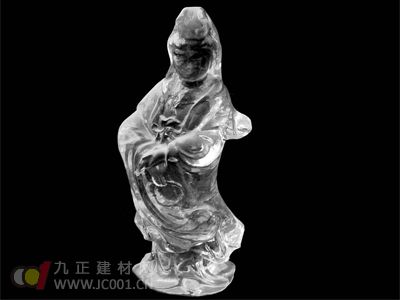Tips for Choosing Crystal Products:
(1) Examine the Material: High-quality crystal products should have a clear and pure texture, without visible gas-liquid inclusions that look like stars, clouds, or flaky patterns. The surface should be smooth and transparent. If you notice cracks or spots of varying depths, it's likely a defective item.
(2) Check the Craftsmanship: Crystal products are typically made using two main techniques—abrasive processing and engraving. Items like necklaces, bracelets, and earrings are usually abrasive, while items like Guanyin statues or inner-painted snuff bottles are engraved. A well-crafted piece should reflect both external beauty (such as design, symmetry, and style) and internal beauty (like clarity and color).

(3) Assess the Polishing: The quality of polishing greatly affects the value of crystal products. Properly polished crystals are honed with diamond sand, ensuring a smooth and glossy finish. Poor polishing may leave friction marks on the surface. High-quality crystals have excellent transparency and a brilliant luster often referred to as "fire."
(4) Inspect the Holes: For crystal jewelry like necklaces or bracelets, check if the holes are straight, evenly thick, and free from small cracks. The walls of the holes should be clear and transparent, without any white marks or imperfections.
(5) Evaluate the Color: Even within the same type of crystal, different parts may have varying colors and textures. A good crystal should have a uniform color without noticeable shading. If there are color variations, they should still look natural and appealing.
(6) Test the Fit: When buying crystal jewelry, try it on to see how it fits your size, tightness, and length. If it has inlays or decorations, make sure they are securely attached and well-coordinated. Also, consider whether the style and color of the crystal complement your skin tone, face shape, and clothing.
Crystals are mined in various regions around the world, with Brazil being one of the largest producers. Uruguay and South Africa also contribute, but some rare types like blonde crystal or green hair crystal are hard to find due to political, economic, and environmental restrictions. These stones are no longer mined, making them extremely rare in the market.
High-quality amethyst is mainly found in Brazil, Uruguay, and the Ural Mountains. Uruguayan amethyst is known for its deep blue and purple hues, which are very rare. However, the deposits are small and not suitable for large-scale mining, so genuine Uruguayan amethyst is almost impossible to find. If someone claims to be selling Uruguayan amethyst at a reasonable price, it's likely fake.
Additionally, because amethyst crystals are typically small, they rarely form into large, hollow pieces. So, if someone tells you they're selling an "amethyst hole" from Uruguay, it's best to walk away. Most amethyst available in the market comes from Brazil, with the highest quality being medium-dark purple with a strong red secondary hue.
The finest amethysts emit a soft red or pink glow from within. As for "Austrian crystal," it's often a term used by sellers to describe glass. While Swarovski does produce man-made crystal, some vendors mislead customers by calling their products "Austrian." If someone mentions this, it’s likely a sign they’re selling glass. Also, keep in mind that Hainan, China, doesn’t produce real crystals, so don’t be fooled by such claims.
Edge Banding,Pvc Edge Banding Tape,Plastic Edge Strip,T Edge Banding
Wuxi Jierui Changkun New Material Technology Co., Ltd , https://www.plasticstrapsll.com
